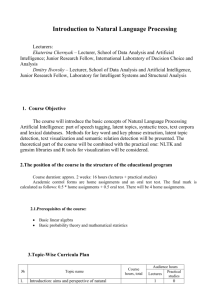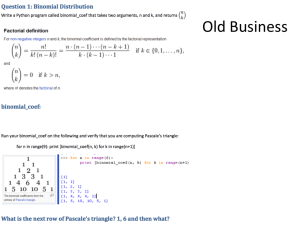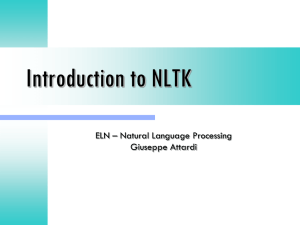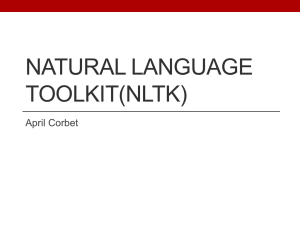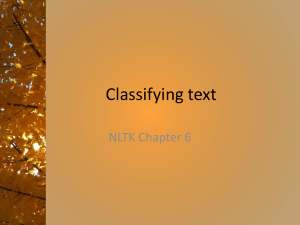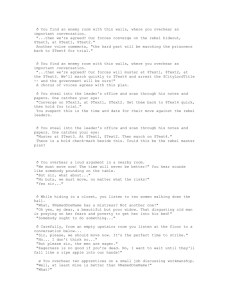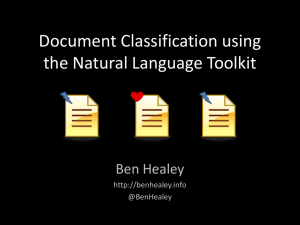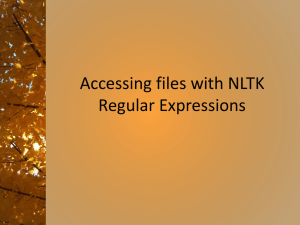Text Analysis with NLTK Cheatsheet - Princeton...Text Analysis with
advertisement
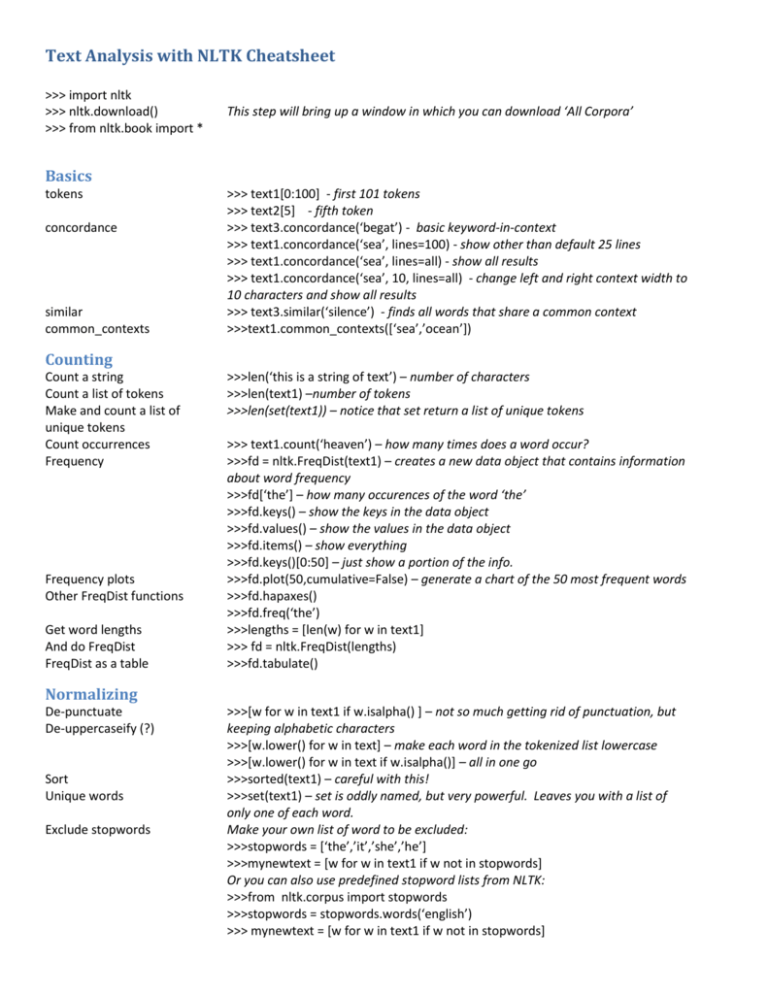
Text Analysis with NLTK Cheatsheet
>>> import nltk
>>> nltk.download()
>>> from nltk.book import *
This step will bring up a window in which you can download ‘All Corpora’
Basics
tokens
concordance
similar
common_contexts
>>> text1[0:100] - first 101 tokens
>>> text2[5] - fifth token
>>> text3.concordance(‘begat’) - basic keyword-in-context
>>> text1.concordance(‘sea’, lines=100) - show other than default 25 lines
>>> text1.concordance(‘sea’, lines=all) - show all results
>>> text1.concordance(‘sea’, 10, lines=all) - change left and right context width to
10 characters and show all results
>>> text3.similar(‘silence’) - finds all words that share a common context
>>>text1.common_contexts([‘sea’,’ocean’])
Counting
Count a string
Count a list of tokens
Make and count a list of
unique tokens
Count occurrences
Frequency
Frequency plots
Other FreqDist functions
Get word lengths
And do FreqDist
FreqDist as a table
>>>len(‘this is a string of text’) – number of characters
>>>len(text1) –number of tokens
>>>len(set(text1)) – notice that set return a list of unique tokens
>>> text1.count(‘heaven’) – how many times does a word occur?
>>>fd = nltk.FreqDist(text1) – creates a new data object that contains information
about word frequency
>>>fd[‘the’] – how many occurences of the word ‘the’
>>>fd.keys() – show the keys in the data object
>>>fd.values() – show the values in the data object
>>>fd.items() – show everything
>>>fd.keys()[0:50] – just show a portion of the info.
>>>fd.plot(50,cumulative=False) – generate a chart of the 50 most frequent words
>>>fd.hapaxes()
>>>fd.freq(‘the’)
>>>lengths = [len(w) for w in text1]
>>> fd = nltk.FreqDist(lengths)
>>>fd.tabulate()
Normalizing
De-punctuate
De-uppercaseify (?)
Sort
Unique words
Exclude stopwords
>>>[w for w in text1 if w.isalpha() ] – not so much getting rid of punctuation, but
keeping alphabetic characters
>>>[w.lower() for w in text] – make each word in the tokenized list lowercase
>>>[w.lower() for w in text if w.isalpha()] – all in one go
>>>sorted(text1) – careful with this!
>>>set(text1) – set is oddly named, but very powerful. Leaves you with a list of
only one of each word.
Make your own list of word to be excluded:
>>>stopwords = [‘the’,’it’,’she’,’he’]
>>>mynewtext = [w for w in text1 if w not in stopwords]
Or you can also use predefined stopword lists from NLTK:
>>>from nltk.corpus import stopwords
>>>stopwords = stopwords.words(‘english’)
>>> mynewtext = [w for w in text1 if w not in stopwords]
Searching
Dispersion plot
Find word that end with…
Find words that start with…
Find words that contain…
Combine them together:
Regular expressions
>>>text4.dispersion_plot([‘American’,’Liberty’,’Government’])
>>>[w for w in text4 if w.endswith(‘ness’)]
>>>[w for w in text4 if w.startsswith(‘ness’)]
>>>[w for w in text4 if ‘ee’ in w]
>>>[w for w in text4 if ‘ee’ in w and w.endswith(‘ing’)]
‘Regular expressions’ is a syntax for describing sequences of characters usually
used to construct search queries. The Python ‘re’ module must first be imported:
>>>import re
>>>[w for w in text1 if re.search('^ab',w)] – ‘Regular expressions’ is too big of a
topic to cover here. Google it!
Chunking
Collocations
Bi-grams
Tri-grams
n-grams
Collocations are good for getting a quick glimpse of what a text is about
>>> text4.collocations() - multi-word expressions that commonly co-occur. Notice
that is not necessarily related to the frequency of the words.
>>>text4.collocations(num=100) – alter the number of phrases returned
Bigrams, Trigrams, and n-grams are useful for comparing texts, particularly for
plagiarism detection and collation
>>>nltk.bigrams(text4) – returns every string of two words
>>>nltk.trigrams(text4) – return every string of three words
>>>nltk.ngrams(text4, 5)
Tagging
part-of-speech tagging
>>>mytext = nltk.word_tokenize(“This is my sentence”)
>>> nltk.pos_tag(mytext)
Working with your own texts:
Open a file for reading
Read the file
Tokenize the text
Convert to NLTK Text object
>>>file = open(‘myfile.txt’) – make sure you are in the correct directory before
starting Python
>>>t = file.read();
>>>tokens = nltk.word_tokenize(t)
>>>text = nltk.Text(tokens)
Quitting Python
Quit
>>>quit()
Part-of-Speech Codes
CC
Coordinating conjunction
CD
Cardinal number
DT
Determiner
EX
Existential there
FW
Foreign word
IN
Preposition or subordinating
conjunction
JJ
Adjective
JJR
Adjective, comparative
JJS
Adjective, superlative
LS
List item marker
MD
Modal
NN
Noun, singular or mass
NNS
NNP
NNPS
PDT
POS
PRP
PRP$
RB
RBR
RBS
RP
SYM
TO
Noun, plural
Proper noun, singular
Proper noun, plural
Predeterminer
Possessive ending
Personal pronoun
Possessive pronoun
Adverb
Adverb, comparative
Adverb, superlative
Particle
Symbol
to
UH
VB
VBD
VBG
participle
VBN
VBP
present
VBZ
present
WDT
WP
WP$
WRB
Interjection
Verb, base form
Verb, past tense
Verb, gerund or present
Verb, past participle
Verb, non-3rd person singular
Verb, 3rd person singular
Wh-determiner
Wh-pronoun
Possessive wh-pronoun
Wh-adverb
Resources
Python for Humanists 1: Why Learn Python?
http://www.rogerwhitson.net/?p=1260
‘Natural Language Processing with Python’ book online
http://www.nltk.org/book/
Commands for altering lists – useful in
creating stopword lists
list.append(x) - Add an item to the end of the list
list.insert(i, x) - Insert an item, i, at position, x.
list.remove(x) - Remove item whose value is x.
list.pop(x) - Remove item numer x from the list.
